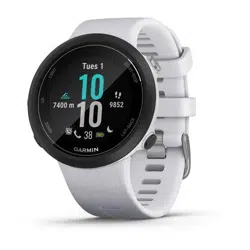Loading ...
Loading ...
Loading ...

NOTE: You may need to add the widget to your widget loop
(Customizing the Widget Loop, page 11).
2
Select START to view your average resting heart rate values
for the last 7 days.
Broadcasting Heart Rate Data to Garmin Devices
You can broadcast your heart rate data from your Garmin Swim
2 device and view it on paired Garmin devices.
NOTE: Broadcasting heart rate data decreases battery life.
1
From the heart rate widget, hold UP.
2
Select Heart Rate Options > Broadcast Heart Rate.
The Garmin Swim 2 device starts broadcasting your heart
rate data, and appears.
NOTE: You can view only the heart rate widget while
broadcasting heart rate data from the heart rate widget.
3
Pair your Garmin Swim 2 device with your Garmin ANT+
®
compatible device.
NOTE: The pairing instructions differ for each Garmin
compatible device. See your owner's manual.
TIP: To stop broadcasting your heart rate data, press any
button, and select Yes.
Broadcasting Heart Rate Data During an Activity
You can set up your Garmin Swim 2 device to broadcast your
heart rate data automatically when you begin an activity. For
example, you can broadcast your heart rate data to an Edge
device while cycling, or to a VIRB
®
action camera during an
activity.
NOTE: Broadcasting heart rate data decreases battery life.
1
From the heart rate widget, hold UP.
2
Select Heart Rate Options > Broadcast During Activity.
3
Begin an activity (Starting an Activity, page 3).
The Garmin Swim 2 device starts broadcasting your heart
rate data in the background.
NOTE: There is no indication that the device is broadcasting
your heart rate data during an activity.
4
Pair your Garmin Swim 2 device with your Garmin ANT+
compatible device.
NOTE: The pairing instructions differ for each Garmin
compatible device. See your owner's manual.
TIP: To stop broadcasting your heart rate data, stop the
activity (Stopping an Activity, page 4).
Setting an Abnormal Heart Rate Alert
CAUTION
This feature only alerts you when your heart rate exceeds or
drops below a certain number of beats per minute, as selected
by the user, after a period of inactivity. This feature does not
notify you of any potential heart condition and is not intended to
treat or diagnose any medical condition or disease. Always defer
to your health care provider for any heart-related issues.
You can set the heart rate threshold value.
1
From the heart rate widget, hold UP.
2
Select Heart Rate Options > Abnormal HR Alert.
3
Select High Alert or Low Alert.
4
Set the heart rate threshold value.
Each time your heart rate exceeds or drops below the threshold
value, a message appears and the device vibrates.
Turning Off the Wrist-based Heart Rate Monitor
The default value for the Wrist Heart Rate setting is Auto. The
device automatically uses the wrist-based heart rate monitor
unless you pair an ANT+ heart rate monitor to the device.
1
From the heart rate widget, hold UP.
2
Select Heart Rate Options > Status > Off.
About Heart Rate Zones
Many athletes use heart rate zones to measure and increase
their cardiovascular strength and improve their level of fitness. A
heart rate zone is a set range of heartbeats per minute. The five
commonly accepted heart rate zones are numbered from 1 to 5
according to increasing intensity. Generally, heart rate zones are
calculated based on percentages of your maximum heart rate.
Fitness Goals
Knowing your heart rate zones can help you measure and
improve your fitness by understanding and applying these
principles.
• Your heart rate is a good measure of exercise intensity.
• Training in certain heart rate zones can help you improve
cardiovascular capacity and strength.
If you know your maximum heart rate, you can use the table
(Heart Rate Zone Calculations, page 8) to determine the best
heart rate zone for your fitness objectives.
If you do not know your maximum heart rate, use one of the
calculators available on the Internet. Some gyms and health
centers can provide a test that measures maximum heart rate.
The default maximum heart rate is 220 minus your age.
Setting Your Maximum Heart Rate
The device uses your user profile information from the initial
setup to estimate your maximum heart rate and determine your
default heart rate zones. The default maximum heart rate is 220
minus your age. For the most accurate calorie data during your
activity, you should set your maximum heart rate (if known).
1
From the watch face, hold UP.
2
Select > User Profile > Max. HR.
3
Enter your maximum heart rate.
Customizing Your Heart Rate Zones and Maximum
Heart Rate
You can customize your heart rate zones based on your training
goals. The device uses your user profile information from the
initial setup to estimate your maximum heart rate and determine
your default heart rate zones. The default maximum heart rate is
220 minus your age. For the most accurate calorie data during
your activity, you should set your maximum heart rate (if known).
1
From the Garmin Connect app, select or .
2
Select Garmin Devices.
3
Select your device.
4
Select User Settings > Heart Rate Zones.
5
Enter your heart rate values for each zone.
6
Enter your maximum heart rate.
7
Select Save.
Heart Rate Features 7
Loading ...
Loading ...
Loading ...
